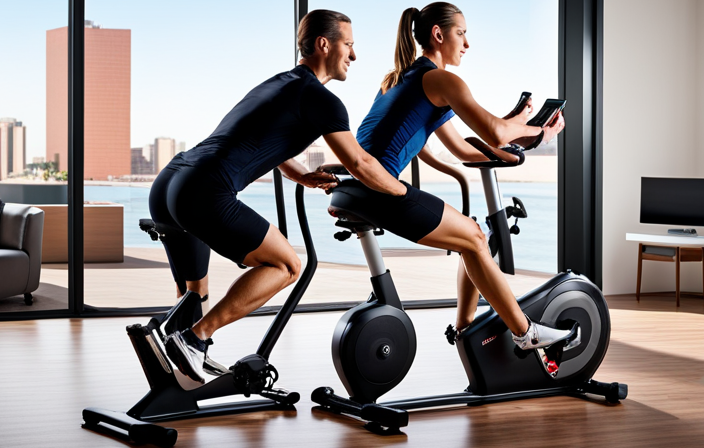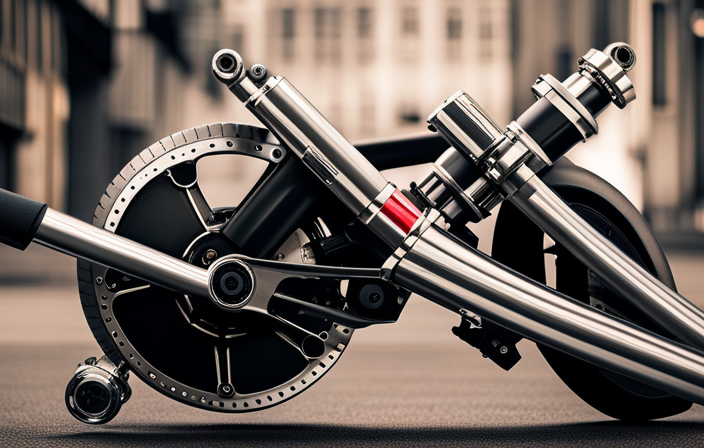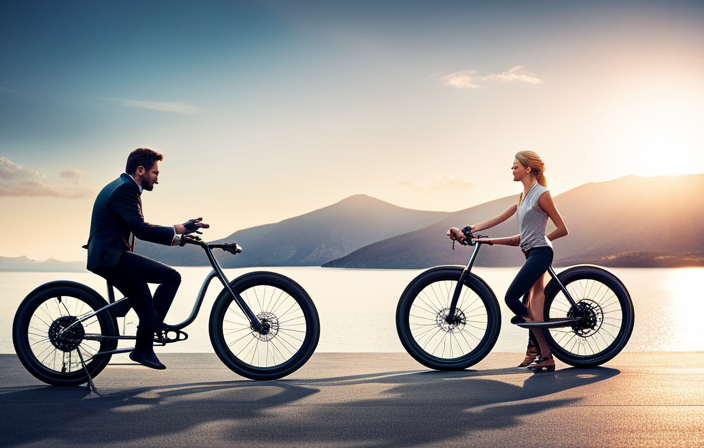I have always been a fan of adventure and discovering new places. Therefore, when I initially learned about the opportunity to bike around Martha’s Vineyard on an electric bike, I was extremely thrilled.
Imagine effortlessly gliding along the scenic routes and bike paths, taking in the breathtaking views of this beautiful island. With the help of an electric bike, I was able to cover more ground and see more of what Martha’s Vineyard has to offer.
In this article, I’ll share my experience and answer the burning question: how many hours does it take to bike around Martha’s Vineyard?
Key Takeaways
- Martha’s Vineyard offers a unique boot-shaped layout with main towns along the eastern edge and rolling hills, farmland, and stunning beaches in the western part.
- The island is home to various historical landmarks and attractions such as Gay Head Lighthouse, Aquinnah Cliffs, Edgartown Lighthouse, Martha’s Vineyard Museum, and Old Whaling Church.
- Katama Beach, Chappaquiddick Island, and Aquinnah Lighthouse are popular destinations with beautiful landscapes and attractions like Mytoi Gardens and Cape Poge Wildlife Refuge.
- When using an electric bike to explore Martha’s Vineyard, it is essential to plan your route, consider the terrain difficulty, estimate travel time, and ensure realistic expectations for breaks and rest stops.
Understanding the Layout of Martha’s Vineyard
Understanding the layout of Martha’s Vineyard can help you plan how many hours it’ll take to bike around. This beautiful island off the coast of Massachusetts is known for its charming towns, picturesque landscapes, and historical landmarks. When it comes to exploring the layout of Martha’s Vineyard, there are a few key areas to consider.
One of the first things you’ll notice about Martha’s Vineyard is its unique shape. The island is roughly shaped like a boot, with the main towns located along the eastern edge. From the bustling downtown of Edgartown to the charming streets of Oak Bluffs, there is plenty to see and do as you navigate the island’s layout.
As you venture further inland, you’ll discover the island’s rolling hills, farmland, and stunning beaches. The western part of Martha’s Vineyard is home to several historical landmarks, including the Gay Head Lighthouse and the Aquinnah Cliffs. These iconic sites offer a glimpse into the island’s rich history and provide breathtaking views of the surrounding area.
Now that you have an understanding of the layout of Martha’s Vineyard, it’s time to start exploring the scenic routes and bike paths that wind their way through the island. From the Martha’s Vineyard State Forest to the scenic coastal roads, there are countless opportunities to soak in the beauty of this enchanting island. So grab your electric bike and get ready for an adventure unlike any other.
Exploring the Scenic Routes and Bike Paths
To fully experience the beauty of Martha’s Vineyard, you’ll want to check out the scenic routes and bike paths available. There are so many amazing sights to see and explore on this picturesque island. Here are four reasons why you should take advantage of the scenic detours and bike paths:
-
Breathtaking Views: The scenic routes on Martha’s Vineyard offer stunning views of the coastline, rolling hills, and charming towns. As you pedal along, you’ll be treated to picturesque landscapes that will take your breath away.
-
Wildlife Encounters: Martha’s Vineyard is home to a diverse range of wildlife, and biking along the bike paths gives you the opportunity to spot some of these amazing creatures. Keep your eyes peeled for deer, foxes, and even the occasional seal or bird species.
-
Peaceful Serenity: One of the best things about biking on Martha’s Vineyard is the sense of tranquility you’ll experience. The bike paths are often less crowded than the main roads, allowing you to enjoy the peacefulness of the island and soak in its natural beauty.
-
Flexibility and Freedom: Exploring Martha’s Vineyard by bike allows you the freedom to take your time and discover hidden gems along the way. You can easily take scenic detours, stop at local shops or cafes, and truly immerse yourself in the island’s unique charm.
By taking advantage of the scenic routes and bike paths on Martha’s Vineyard, you’ll be able to fully appreciate the island’s beauty and create unforgettable memories.
Now, let’s dive into the next section and explore the introduction to electric bikes and their benefits.
Introduction to Electric Bikes and their Benefits
Exploring Martha’s Vineyard is made even more convenient and enjoyable with the introduction of electric bikes and their numerous benefits.
Electric bikes, also known as e-bikes, provide a fantastic way to navigate the island’s picturesque landscapes without the fatigue and strain that traditional bicycles can sometimes bring.
One of the key advantages of electric bikes is that they offer pedal-assist technology, which means that you can choose the level of assistance you need while pedaling. This feature is particularly useful when tackling hilly terrains or longer distances, as it allows you to conserve energy and ride for longer periods.
When choosing the right electric bike for your Martha’s Vineyard adventure, consider factors such as battery range, motor power, and bike weight. A bike with a longer battery range will ensure that you can cover more ground without worrying about running out of power. Additionally, a powerful motor will provide the necessary assistance on challenging terrains. Lastly, a lightweight electric bike will make it easier to maneuver and transport when necessary.
By opting for an electric bike, you’ll have the opportunity to explore Martha’s Vineyard at your own pace, taking in the breathtaking scenery and enjoying the fresh air without feeling exhausted. These bikes are a game-changer when it comes to cycling experiences, offering a blend of exercise and ease that is hard to beat.
As you plan your route and set realistic expectations for your Martha’s Vineyard adventure, consider the advantages that electric bikes bring to the table. With their assistance, you can tackle longer distances and conquer challenging terrains with ease.
Planning Your Route and Setting Realistic Expectations
As you plan your route and set realistic expectations for your adventure around Martha’s Vineyard, it’s important to consider various factors that will affect your journey. One of the key planning strategies is to take into account the terrain difficulty of the different trails and roads on the island. Some areas may have steep inclines or rough terrain, which can significantly impact the time it takes to complete certain distances. Another important aspect to consider is time management. It’s essential to estimate how long it will take to travel between different points of interest, allowing for breaks and rest stops along the way. To help you visualize and plan your route effectively, here is a table highlighting some popular destinations on Martha’s Vineyard and the approximate time it may take to reach them using an electric bike:
| Destination | Distance (Miles) | Estimated Time (Hours) |
|---|---|---|
| Edgartown | 7 | 1.5 |
| Aquinnah Cliffs | 20 | 3.5 |
| Menemsha Harbor | 12 | 2.5 |
| West Tisbury Farmers Market | 10 | 2 |
| Chappaquiddick | 8 | 1.5 |
With these planning strategies and an awareness of the time it takes to travel certain distances, you can better manage your adventure around Martha’s Vineyard. Now, let’s dive into the starting point: Oak Bluffs, where your journey begins.
Starting Point: Oak Bluffs
When you arrive in Oak Bluffs, take a moment to soak in the vibrant atmosphere of this charming town. Oak Bluffs serves as the perfect starting point for your biking adventure around Martha’s Vineyard. With its picturesque streets lined with colorful Victorian cottages, bustling harbor, and lively downtown area, Oak Bluffs sets the tone for an exciting and enjoyable journey.
As you hop on your electric bike, you’ll be amazed by the convenience and ease it provides. With the assistance of the electric motor, you’ll be able to cover more ground and explore the island at a comfortable pace. The duration of your bike ride will depend on various factors such as your fitness level, the stops you make along the way, and the specific route you choose. On average, biking around Martha’s Vineyard can take anywhere from 4 to 6 hours.
Heading east from Oak Bluffs, you’ll find yourself venturing into the charming towns of Edgartown and Katama. These areas offer their own unique attractions, from the historic architecture in Edgartown to the stunning beaches in Katama. So, get ready to continue your journey as you pedal towards the next chapter of your Martha’s Vineyard adventure.
Heading East: Edgartown and Katama
After exploring Oak Bluffs and admiring its charming Victorian cottages, it’s time to continue my electric bike adventure around Martha’s Vineyard.
Heading eastward, I pedal towards the picturesque town of Edgartown and the stunning Katama Beach.
Edgartown Attractions:
As I approach Edgartown, the first thing that catches my eye is the iconic Edgartown Lighthouse. It stands proudly at the entrance of the harbor, offering breathtaking views of the coastline. The town itself is filled with historic buildings, boutique shops, and delicious seafood restaurants. I make a mental note to explore the Martha’s Vineyard Museum and the Old Whaling Church later on.
Katama Beach Activities:
Leaving Edgartown behind, I make my way towards the famous Katama Beach. Known for its soft sandy shores and rolling waves, this beach is a paradise for sunbathers and water sports enthusiasts alike. I can’t resist the temptation to dip my toes in the refreshing Atlantic Ocean and soak up the sun on this beautiful stretch of coastline.
Enjoying the Outdoors:
Apart from the attractions, Edgartown and Katama Beach offer plenty of opportunities to enjoy the outdoors. From kayaking in the calm waters of Katama Bay to exploring the scenic trails at Felix Neck Wildlife Sanctuary, there’s something for everyone seeking outdoor adventures.
As I bid farewell to Edgartown and Katama Beach, I eagerly set my sights on the next leg of my journey, southward bound towards the captivating Chappaquiddick Island.
Southward Bound: Chappaquiddick Island
Leaving Edgartown and Katama Beach behind, I’m excited to explore the captivating Chappaquiddick Island on my electric bike adventure. Chappaquiddick Island, located just south of Martha’s Vineyard, offers a wealth of attractions and bike trails to discover. As I pedal along, I can’t help but be amazed by the natural beauty of this island paradise.
One of the must-visit attractions on Chappaquiddick Island is the Mytoi Gardens. These Japanese-style gardens are a tranquil oasis, featuring serene ponds, vibrant flowers, and winding paths. It’s the perfect spot to take a break and soak in the peaceful surroundings.
Another highlight of my bike ride is the Cape Poge Wildlife Refuge. This expansive area is home to various bird species and other wildlife. As I ride through the trails, I keep my eyes peeled for ospreys, herons, and even the occasional seal basking in the sun.
To give you a better idea of the layout of Chappaquiddick Island and its attractions, here’s a handy table:
| Attractions | Location | Description |
|---|---|---|
| Mytoi Gardens | East of ferry | Japanese-style gardens with serene ponds |
| Cape Poge Wildlife | North of ferry | Refuge with diverse bird species and wildlife |
| Wasque Reservation | South of ferry | Beach and trails with stunning ocean views |
As I continue my journey, I look forward to taking in the views of Aquinnah and the majestic cliffs that await me.
Taking in the Views: Aquinnah and the Cliffs
To fully appreciate the beauty of Aquinnah and its majestic cliffs, you should make sure to visit the iconic Aquinnah Lighthouse. This picturesque spot is not only a historic landmark but also offers breathtaking views of the surrounding landscape. As you approach the lighthouse, you’ll be greeted by the stunning sight of the vibrant red clay cliffs, which are a unique geological feature of this area. Taking memorable photos is a must here, as the combination of the lighthouse and the cliffs creates a truly awe-inspiring backdrop.
One of the best times to visit the Aquinnah Lighthouse is during sunset. The golden light casts a magical glow over the cliffs, making it an ideal setting for capturing stunning sunset views and photo opportunities. As the sun slowly descends, the colors in the sky intensify, creating a mesmerizing spectacle that will leave you in awe.
After taking in the beauty of Aquinnah, your journey continues northward to Vineyard Haven and West Tisbury, where more adventures and discoveries await. These charming towns offer a different kind of beauty, with their quaint streets, art galleries, and local shops. Exploring the vibrant culture and history of these areas will further enrich your Martha’s Vineyard experience.
Transitioning from the rugged cliffs of Aquinnah to the charming towns of Vineyard Haven and West Tisbury, you’ll find yourself immersed in a different side of the island’s allure.
Northward Bound: Vineyard Haven and West Tisbury
After taking in the breathtaking views of Aquinnah and the Cliffs, it’s time to continue my journey around Martha’s Vineyard. Heading northward, I find myself in the charming town of Vineyard Haven. This bustling hub is known for its vibrant downtown area and numerous attractions.
As I navigate the streets on my electric bike, I can’t help but admire the historic homes and quaint shops that line the main thoroughfare. One of the highlights of Vineyard Haven is the Martha’s Vineyard Museum, where I can delve into the island’s rich history and culture. The museum offers an array of exhibits and interactive displays that provide fascinating insights into the island’s past.
To fully immerse myself in nature, I make my way to West Tisbury, a serene town nestled in the heart of Martha’s Vineyard. Here, I discover an extensive network of bike trails that wind through picturesque landscapes, including lush forests and rolling meadows. These trails offer a perfect opportunity to explore the island’s natural beauty at a leisurely pace.
Before I continue my journey, let’s take a closer look at the attractions in Vineyard Haven and the bike trails in West Tisbury:
| Vineyard Haven Attractions | West Tisbury Bike Trails |
|---|---|
| Martha’s Vineyard Museum | State Forest Trail |
| Owen Park | West Tisbury Bike Path |
| Main Street | Sepiessa Point |
Now, it’s time to hop back on my electric bike and head towards the central region of Martha’s Vineyard, where Menemsha and Chilmark await with their own unique charms and attractions.
Exploring the Central Region: Menemsha and Chilmark
As I explore the central region of Martha’s Vineyard, I can’t wait to discover the unique charms and attractions of Menemsha and Chilmark. These two destinations offer a delightful blend of coastal beauty and rural serenity, making them must-visit spots on any Martha’s Vineyard itinerary.
-
Menemsha Fishing Village: Nestled on the western coast of the island, Menemsha is a picturesque fishing village that exudes authentic New England charm. Strolling along the docks, you can watch local fishermen unload their catches of the day or even try your hand at fishing. As the sun sets, the village transforms into a magical place, with vibrant hues painting the sky and the smell of fresh seafood wafting through the air.
-
Chilmark Farms: Known for its idyllic landscapes and thriving agricultural community, Chilmark is a haven for farm enthusiasts. Here, you can explore charming farm stands offering fresh produce, flowers, and homemade goods. Take a leisurely bike ride through the scenic countryside, passing by rolling hills and picturesque farms. Don’t forget to sample some of the delicious farm-to-table cuisine that Chilmark is renowned for.
As I continue my journey through Martha’s Vineyard, I’m excited to discover the hidden gems and amazing pit stops and refreshments along the way.
Pit Stops and Refreshments along the Way
Don’t forget to make pit stops along the way to try out the delicious local refreshments that Martha’s Vineyard has to offer. As you explore the island on your electric bike, you’ll come across numerous picnic spots where you can take a break and indulge in the island’s mouthwatering cuisine.
One popular spot is the Black Dog Tavern, located in Vineyard Haven. Known for its fresh seafood and waterfront views, it’s the perfect place to refuel and enjoy a leisurely meal. Another great option is Larsen’s Fish Market in Menemsha, where you can savor their famous lobster rolls while taking in the picturesque harbor scenery. For those with a sweet tooth, don’t miss a visit to Backdoor Donuts in Oak Bluffs. Their warm, freshly baked donuts are a true delight.
As you continue your biking adventure, be sure to stay hydrated and energized by sampling the local fare at these charming picnic spots.
Now that you know where to find the best local refreshments, let’s talk about safety tips and precautions for biking on the island.
Safety Tips and Precautions for Biking on the Island
Now that we’ve covered the importance of pit stops and refreshments along the way, let’s focus on some safety tips and precautions for biking on Martha’s Vineyard. As an avid cyclist who has explored every corner of this beautiful island, I want to ensure that you have the best experience possible.
Here are a few things to keep in mind:
-
Regular Bike Maintenance: Before setting off on your biking adventure, make sure your electric bike is in top-notch condition. Check the tires, brakes, and gears to ensure they are working properly. A well-maintained bike will provide a smooth and safe ride.
-
Staying Hydrated: Biking can be physically demanding, especially under the sun. It’s crucial to stay hydrated throughout your journey. Bring a water bottle and refill it whenever possible. There are plenty of convenient spots along the way where you can find drinking water or purchase a refreshing beverage.
-
Wearing the Right Gear: Always wear a helmet to protect your head in case of any accidents. Additionally, consider wearing bright and reflective clothing to increase your visibility to other road users.
By following these safety tips and precautions, you’ll be well-prepared for your biking adventure on Martha’s Vineyard.
Now, let’s dive into considering the weather and seasonal factors that can impact your ride.
Considering the Weather and Seasonal Factors
Considering the weather and seasonal factors, it’s important to be prepared for any changes in conditions while biking on Martha’s Vineyard.
The island’s unique climate and diverse terrain can greatly impact your biking experience. One of the primary factors affecting biking speed is wind. Martha’s Vineyard is known for its strong coastal winds, which can either work in your favor or against you. When selecting an electric bike, it’s crucial to choose one that can handle varying wind speeds and provide sufficient power to assist you in pedaling.
Another factor to consider is the terrain. Martha’s Vineyard offers a mix of flat roads, hilly areas, and off-road trails. Opting for an electric bike with multiple gears and a sturdy frame will ensure that you can navigate the island’s diverse topography with ease.
Additionally, the seasonal changes can impact your biking experience. Summers can be hot and humid, so it’s essential to stay hydrated and wear appropriate clothing. Fall and spring bring cooler temperatures, while winter can be chilly and snowy. It’s crucial to check weather forecasts and dress accordingly to stay comfortable and safe during your ride.
With proper preparation, you can fully enjoy biking on Martha’s Vineyard, taking breaks and enjoying the island’s attractions.
Taking Breaks and Enjoying the Island’s Attractions
It’s important to take breaks and explore the various attractions on Martha’s Vineyard while biking. Not only does it give you a chance to rest and recharge, but it also allows you to fully immerse yourself in the beauty and charm of this unique island.
Here are four reasons why taking breaks and enjoying the island’s attractions is a must:
-
Taking scenic photographs: Martha’s Vineyard is a photographer’s paradise. From the picturesque lighthouses to the stunning beaches, there are countless opportunities to capture breathtaking moments. So, make sure to bring your camera and take some time to snap those unforgettable shots.
-
Trying local cuisine: One of the best ways to experience a destination is through its food. Martha’s Vineyard offers a wide range of culinary delights, from freshly caught seafood to farm-to-table dishes. Take a break from biking and savor the local flavors at one of the island’s charming cafes or restaurants.
-
Exploring charming towns: Martha’s Vineyard is home to several quaint towns, each with its own unique character. From the colorful gingerbread cottages in Oak Bluffs to the historic streets of Edgartown, wandering through these charming towns is like stepping back in time. Take a break from biking and stroll through the streets, browsing boutique shops and soaking up the island’s rich history.
-
Enjoying nature’s beauty: Martha’s Vineyard is blessed with stunning natural landscapes, from rolling hills to serene ponds. Take a break from biking and immerse yourself in nature’s beauty. Take a leisurely walk along the coastline, hike through the island’s nature preserves, or simply find a peaceful spot to sit and enjoy the breathtaking views.
By taking breaks and exploring the various attractions on Martha’s Vineyard, you’ll create memories that will last a lifetime.
Now, let’s wrap up your adventure and reflect on the incredible experiences you’ve had on this enchanting island.
Wrapping Up Your Adventure: Reflections and Memories
As I wrap up my adventure on Martha’s Vineyard, I can’t help but reflect on the incredible memories I’ve made during my time exploring the island’s attractions. From the picturesque beaches to the charming towns, every moment has been filled with beauty and wonder.
One of the best ways I’ve captured these memories is through photography. With every click of the camera, I’ve been able to freeze these special moments in time and preserve them forever. Whether it’s a stunning sunset over the ocean or a quaint little cottage tucked away in the woods, each photo tells a story and allows me to relive the magic of this journey.
The island’s natural beauty has provided me with endless opportunities to capture breathtaking landscapes, vibrant wildlife, and charming architecture. As I look back on these photos, I can’t help but feel a sense of gratitude for the experiences I’ve had and the memories I’ve made.
Martha’s Vineyard will always hold a special place in my heart, and these photographs will serve as a reminder of the incredible journey I’ve had.
Frequently Asked Questions
Are there any bike rental shops on Martha’s Vineyard?
Yes, there are several bike rental shops available on Martha’s Vineyard. These shops offer a variety of bike rental options to suit your needs.
The cost of renting a bike varies depending on the type of bike and duration of rental. You can choose from regular bikes, electric bikes, or even tandem bikes.
Renting a bike is a convenient and affordable way to explore the beautiful sights of Martha’s Vineyard at your own pace.
Can I bring my own electric bike to Martha’s Vineyard?
Bringing your own electric bike to Martha’s Vineyard is a fantastic idea! Picture yourself effortlessly cruising along the picturesque roads, feeling the wind in your hair and the sun on your face.
Not only can you bring your electric bike on public transportation, but it also offers numerous benefits on the island. You’ll be able to explore the beautiful scenery while reducing your carbon footprint and enjoying the ease and convenience of an electric bike.
Are there any restrictions or regulations for biking on the island?
There are certain biking regulations and safety measures in place on Martha’s Vineyard. These regulations aim to ensure the safety and enjoyment of all cyclists on the island.
It is important to follow traffic laws, wear a helmet, and use hand signals when turning. Additionally, it is recommended to stay on designated bike paths and be mindful of pedestrians.
What is the average speed of an electric bike on Martha’s Vineyard?
The average speed of an electric bike on Martha’s Vineyard is around 20 miles per hour.
Riding an electric bike offers numerous benefits, including faster travel times, less effort required, and the ability to cover more ground in a shorter period.
With an electric bike, you can explore the beautiful sights and attractions of Martha’s Vineyard while enjoying a comfortable and efficient ride.
It’s a fantastic way to experience the island’s charm and make the most of your time.
Are there any charging stations for electric bikes available along the routes?
Yes, there are charging stations available along the routes on Martha’s Vineyard. These charging stations ensure that electric bike riders can conveniently recharge their bikes during their journey. This is especially useful for those who are concerned about the battery life of their electric bikes.
Additionally, Martha’s Vineyard offers alternative transportation options such as bike rentals and public transportation, making it easy for visitors to explore the island sustainably and conveniently.
Conclusion
In conclusion, biking around Martha’s Vineyard using an electric bike is a fantastic way to explore the island’s scenic routes and bike paths.
With careful planning and realistic expectations, you can navigate the island comfortably and enjoy all its attractions. Remember to prioritize safety, consider weather conditions, and take breaks to fully appreciate the beauty of the island.
As you wrap up your adventure, you’ll be left with unforgettable memories and a deeper understanding of Martha’s Vineyard. So, hop on your electric bike and embark on this incredible journey!









